Flowering Clematis: Pruning, Transplanting, Trellis Support and Care Guide
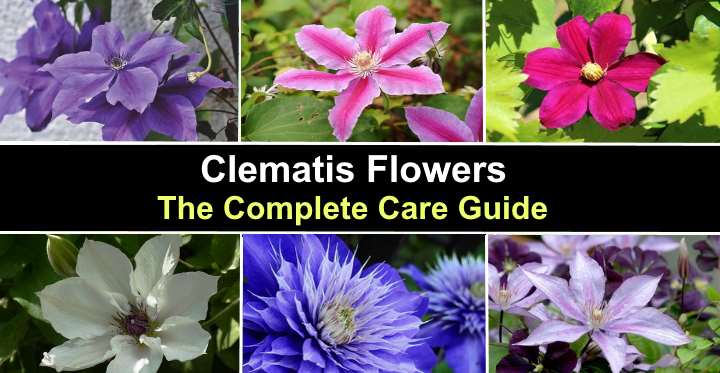
Clematis flowers are beautiful star-shaped or bell-shaped blossoms that grow profusely on trailing and climbing vines. Impressive flowering clematis vines thrive in sunny gardens with minimal care. Colorful clematis flowers bloom in shades of purple, pink, rosy-red, white, yellow, and lilac. Some of the largest clematis blooms are enormous fragrant flowers growing up to 10” (25 cm) across.
Clematis vines are versatile garden plants that add color and beauty to landscapes. With the proper care, clematis flowers can be trained to grow over trellises, pergolas, arbors, along fence lines, or scramble over walls. You can also grow compact flowering clematis plants in containers and support them with a decorative trellis. This makes clematis flowers ideal for patios, container gardens, or balconies.
This article is a complete guide to caring for a flowering clematis vine in your garden landscape. As well as learning about watering and fertilizing clematis plants, you will get handy tips on how to prune clematis flowers to maximize their bloom time.
How to Care for Clematis
To grow flowering clematis, plant the vine in full sun or partial shade. Clematis flowers thrive when grown in moist, well-drained soil. For best results, spread a thick layer of mulch to keep the soil cool and encourage blooming from spring until summer. Prune clematis annually to ensure plenty of flowers.
How to Prune Clematis Vine

Pruning clematis is done every year depending on the type of vine and blooming time
Clematis vines need trimming back every year to reduce leggy growth and promote blooming. Pruning clematis plants depends on when they bloom. Clematis in group 1 bloom on old wood and need pruning after flowering in summer. Clematis plants in groups 2 and 3 should be pruned in late fall, winter, or early spring.
Deadheading a flowering clematis vine encourages a second wave of blooming and makes the vines bloom longer.
The goal of pruning clematis is to create a robust, free-flowering vine that produces masses of blooms every year.
Here is a handy guide as to when to prune clematis vines:
Pruning clematis plants in group 1
Early blooming clematis (spring bloomers – bloom on the previous year’s growth) only require light pruning when the vine has finished flowering in early summer. You should prune back deadwood if necessary.
Pruning clematis plants in group 2
Early summer clematis (repeat bloomers – bloom on the previous year’s growth)— bloom on old and new wood: the first blooming is in spring on old ripened growth from the previous year; the second is on the current year’s growth. It would be best if you deadhead spent blooms in late summer to encourage repeat blooms. You should prune back deadwood in fall or winter. In addition, you can trim back hard every few years, leaving about 12” (30 cm) of stems above the soil level.
Pruning clematis plants in group 3
Late-blooming clematis (summer or fall bloomers) bloom on new wood and need hard pruning in winter to trim back to 12” (30 cm) tall and leave strong buds on the stems.
When Do Clematis Bloom
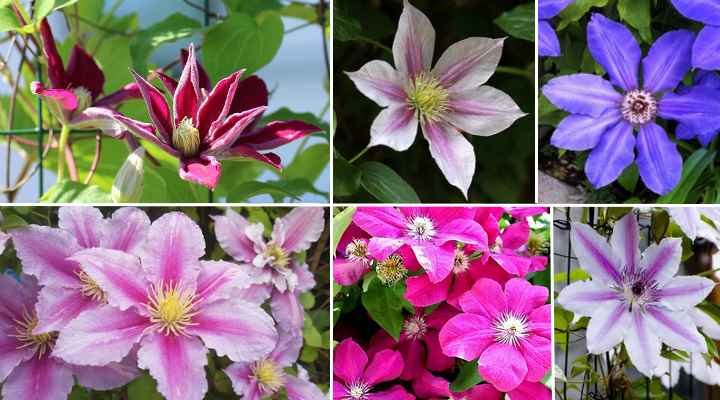
Clematis blooming time depends on the variety and can be early or late-season
Clematis bloom times depend on the type of vine and when the buds appear. When clematis flowering vines bloom, they are some of the most spectacular flowers in a garden. The colorful star-shaped flowers growing tall vines add vertical accents and focal points in spring and summer gardens.
Clematis vines are categorized by their bloom time as follows:
- Evergreen clematis: The earliest clematis vines to flower are the evergreen varieties that thrive in zones 7 to 10. Small bell- or urn-shaped flowers appear as early as midwinter and persist until early spring.
- Early bloomers: Flowers appear from March through June and bloom on old wood. You should trim the stems back after flowering.
- Mid-season bloomers: The deciduous vines bloom with large flowers from April through June. Buds form on old and new wood, and you can lightly prune the vines in early spring.
- Late-season bloomers: Flowering occurs from July and persists until the first frost. Buds form on new wood; therefore, hard pruning in late winter or early spring is crucial.
How Long Clematis Plants Bloom
Clematis flowers bloom in spring and summer and persist for several weeks. Most varieties of clematis vines bloom for a few weeks and then produce repeat blooms 30 to 45 days later. However, the length clematis flowers bloom for depends on the group and your growing zone.
Do you want clematis blooms all year long? Clematis is called the queen of climbers due to the spectacular flowers the vining plants produce. By planting various clematis vines in your garden, you could have clematis in bloom from early spring until late fall.
How Tall Clematis Grow
The average clematis vine can climb between 6 and 15 ft. (1.8 – 4.5 m) tall. However, some taller clematis hybrids can reach staggering heights of 20 to 40 ft. (6 – 12 m) if they get enough support. But if you have a small garden, compact clematis plants that grow in containers are ideal — they only grow 3 to 6 ft. (0.1 – 1.8 m) tall.
How to Support Climbing Clematis Vine
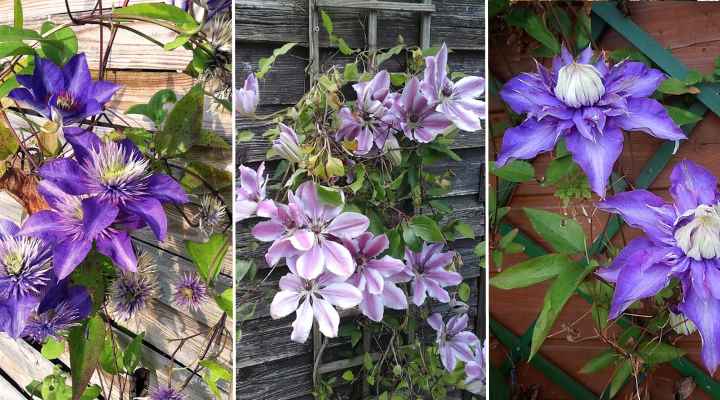
Clematis vines supported by trellis
Clematis vines are excellent climbers if they get the proper support. Unlike other climbing vines, clematis vines don’t stick to smooth surfaces. Instead, the leaf stems act like tendrils and wrap around slender objects like wire, string, or frames like a trellis, arbor, pergola, wire fence, or other similar supports.
The easiest way to support a climbing clematis plant is to use a decorative frame. However, even with a suitable trellis or arbor, it’s worth using netting or twine helper lines to give the stems something to “grab” onto.
As a rule, clematis vines need structures less than 0.75” (1.9 cm) to cling onto. For example, you can train a clematis to grow up a pole or tree if you attach fishing wire up it. Tie knots every 12” (30 cm) to prevent the flowering vine from slipping down under its own weight.
Clematis is an ideal plant for a fence line because it spreads and climbs. However, to plant a clematis along a fence line, you should attach a clematis mesh or clematis netting for support. Alternatively, you could hammer nails into the wall or fence to run fishing wire between the nails for support.
Clematis Trellis
Clematis is an ideal flowering vining plant to grow over a trellis. However, the trellis should be installed before planting the clematis to avoid damaging the roots. When choosing a suitable clematis trellis, buy one that matches the height of the mature vine. Also, the trellis should be at least 6” (15 cm) away from walls to allow plenty of air circulation.
How to Propagate Clematis
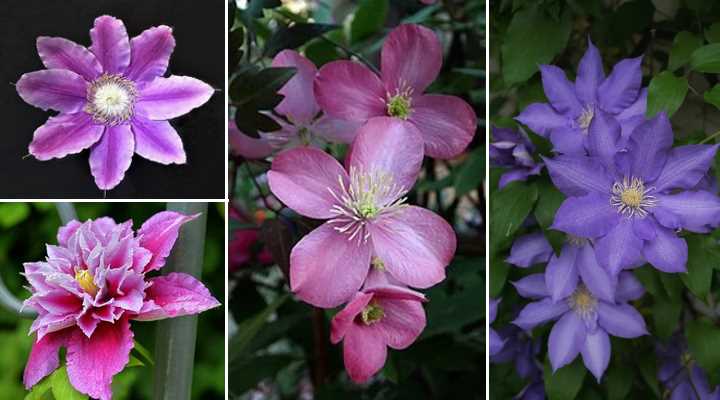
You can easily propagate clematis from cuttings
The easiest way to propagate clematis is from cuttings. In early summer, cut a few lengths of healthy, half-green wood stems from your plant about 3 ft. (1 m) long. Cut the stem just above a leaf joint and then divide the stems by cutting about 2” (5 cm) below a leaf joint.
Dip the cut ends in rooting hormone and plant the vines in a pot filled with one-part compost and one-part horticultural grit. Insert the cuttings around the edge of the container until the leaf joint is level with the soil surface. Water the soil to moisten it and cover it with plastic to lock in heat and moisture.
While the cuttings are taking root, keep the potting soil moist. It takes one to two months for the cutting to root. After this, you can transfer the propagated clematis cuttings to the garden.
How to Plant Clematis Vines
Clematis vines are an excellent addition to any garden that gets full to partial sun. As long as you keep the soil moist and prune at the appropriate times, clematis flowers will bloom year after year, and the plant’s lush foliage acts as a privacy shield from spring until late fall.
When to Plant Clematis
Plant clematis vines in spring or early fall to allow their roots to get established. The warm, moist soil at these times helps newly-planted clematis plants thrive through the growing season. Never transfer a potted clematis to the garden if the ground is frozen, waterlogged, or arid.
Where to Grow Clematis Plants
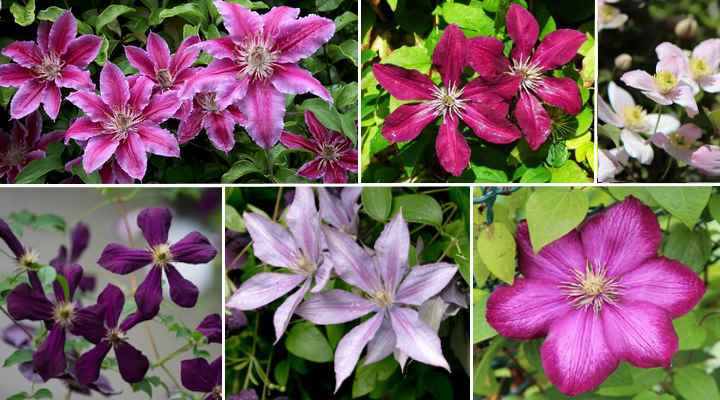
Clematis vines grow best in full sun but the roots need to be protected from direct sunlight
The best place to plant a clematis is where the vines get full sun. You should aim for six to eight hours of sunlight daily. However, clematis roots must be in the shade or protected from direct sunlight. Clematis vines prefer cool roots, so either use mulch or plant small shrubs around them to protect them and keep the ground cool.
Another consideration for the planting site is the soil type. Clematis flowers thrive when growing in organically rich, moist, well-drained soil. If necessary, you may need to work in plenty of compost into the ground to add nutrients, retain moisture, and help the soil drain better.
How to plant clematis vines in the garden
To plant a clematis vine in the ground, dig a hole twice the width of the root ball and about the same depth. Plant the vine in the hole, and backfill with native soil, ensuring the crown is 2” to 3” (5 – 7.5 cm) below the surface. Press down the ground to remove air pockets.
Next, spread a 3” to 4” (7.5 – 10 cm) layer of mulch over the root area. Mulching helps to keep the roots cool, prevents weeds from emerging, and helps retain moisture.
How to Grow Clematis in Containers
Compact clematis vines are the perfect container plant if you want a tall flowering plant on your patio, paved garden, deck, balcony, or beside an entranceway. A clematis vine should be planted in a pot with drain holes to thrive. Also, choose a planter that can support a frame for the clematis vine to climb.
To keep the roots cool, plant low-growing herbs or annuals in the planter to provide shade. Alternatively, you could use organic mulch to shade the roots.
How to Care for Flowering Clematis Vines
Clematis cultivars and hybrids are some of the most popular flowering vines due to their low maintenance. As long as the flowers get plenty of sunshine and the ground stays moist and cool, you should have no trouble caring for the attractive vining plant.
Clematis Growing Zones
Clematis plants are suitable for growing in USDA zones 4 through 9. However, some hardy varieties are ideal for growing in zone 3. Other heat-loving clematis and evergreen clematis thrive in zones 7 to 11.
How to Water Clematis Plants

Clematis vines grow well when the soil is moist
Clematis flowers thrive when they grow in moist soil. Therefore, keeping the soil moist is essential for growing clematis in the ground or planters. Water clematis whenever the top 1” (2.5 cm) layer of soil dries out. Usually, an established clematis plant needs 1” (2.5 cm) of water every week.
However, watering frequency depends on the weather — for example, hot sun or rainfall changes the amount of water you must give the vine growing in the ground.
How often should you water a clematis growing in a container? You usually need to water the vine two to three times a week during summer. However, always ensure that the top 1” (2.5 cm) of soil is dry, but never allow the soil to dry out completely.
Top tip when watering a clematis: The best time to water the flowering vine is in the morning. This allows plenty of moisture to get to the roots and prevents evaporation.
Fertilizing Clematis Vine
Clematis plants have relatively high nutrient requirements to support blooming throughout the season. Therefore, you should apply plenty of compost around the root area every spring. Then fertilize the vine every four to six weeks during the growing season.
The best way to fertilize a healthy clematis vine is to alternate between a balanced all-purpose fertilizer and a low nitrogen fertilizer. For example, use a fertilizer with an NPK rating of 5-10-10 one month and then a 10-10-10 fertilizer the following month.
You shouldn’t fertilize a clematis between late fall and the end of winter.
Pests Affecting Clematis Growth
Common garden bugs that affect clematis leaves and flowers are aphids, scale insects, spider mites, whiteflies, thrips, vine weevils, and caterpillars.
Plant damage caused by some bugs like aphids, whiteflies, thrips, and scales can result in yellowing leaves or wilted foliage. Use a sharp blast of water from the garden hose to get rid of these pesky insects from your flowering clematis plants.
Medium-sized black beetles — clematis vine weevils — can become a problem when they lay eggs in the soil. When the larvae hatch, they feed voraciously on clematis vine roots and can cause a once healthy plant to wither and die.
Caterpillars and earwigs can ruin clematis foliage by chewing holes in the leaves. Unfortunately, earwigs can be particularly challenging to eradicate because they are small and only come out at night.
The best way to get rid of caterpillars is to handpick them from under the leaves and drop them into a bucket of soapy water.
Diseases Affecting Clematis Growth
Two common foliar diseases that affect flowering clematis vines are clematis wilt and powdery mildew. Both are fungal diseases; however, wilt is the more serious of the two.
Clematis wilt causes the lush vine to shrivel up and eventually die. Unfortunately, there is no cure for clematis wilt. However, you can prevent the fungal disease in the soil by keeping it evenly moist and always watering at the base of the plant, not the foliage.
Lack of air circulation or cool, humid conditions cause powdery mildew — a white powder-like substance on leaves. While powdery mildew is not harmful, but it makes the lush vine leaves appear unsightly. The best way to get rid of powdery mildew is to remove affected foliage and increase airflow around the plant.
Related reading: How to treat powdery mildew.
Reasons Why Clematis isn’t Blooming
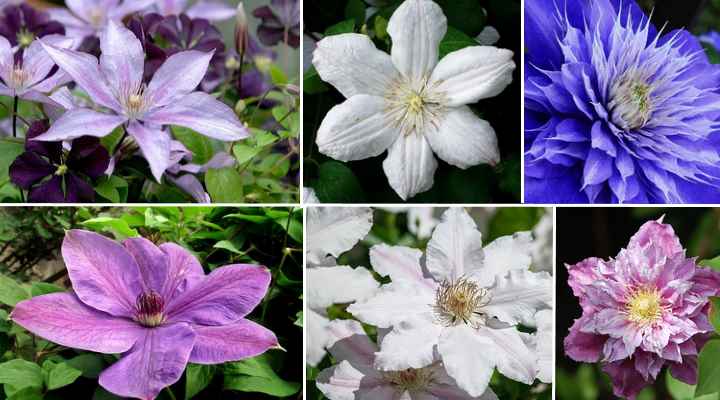
Your clematis vine may not bloom due to lack of the right conditions, improper pruning or the plant is too young
Here are the most common reasons why a clematis vine fails to produce flowers:
- Improper pruning: It’s vital to prune clematis according to its group. Pruning a vine’s stems too early could remove stems with buds. So, always check the type of clematis you have before trimming it back.
- Using the wrong fertilizer: Clematis is a heavy feeder. However, a high-nitrogen fertilizer will encourage leafy growth and leave less energy for the vine to produce flowers.
- Wrong conditions: Clematis vines must grow in full sun but have their feet in the shade. If your vine is getting six hours of sunlight but not producing flowers, plant a few shrubs around the base to provide some shade for the roots.
- Age affects blooming: A new clematis usually takes two to three years to produce the number of blooms you expect. So, be patient and continue to care for the flowering vine, and you should get clematis flowers in a season or two.
Related articles:
- Types of Clematis Vines – Identification Guide
- Stunning purple flowering vines
- Vines with Red Flowers
